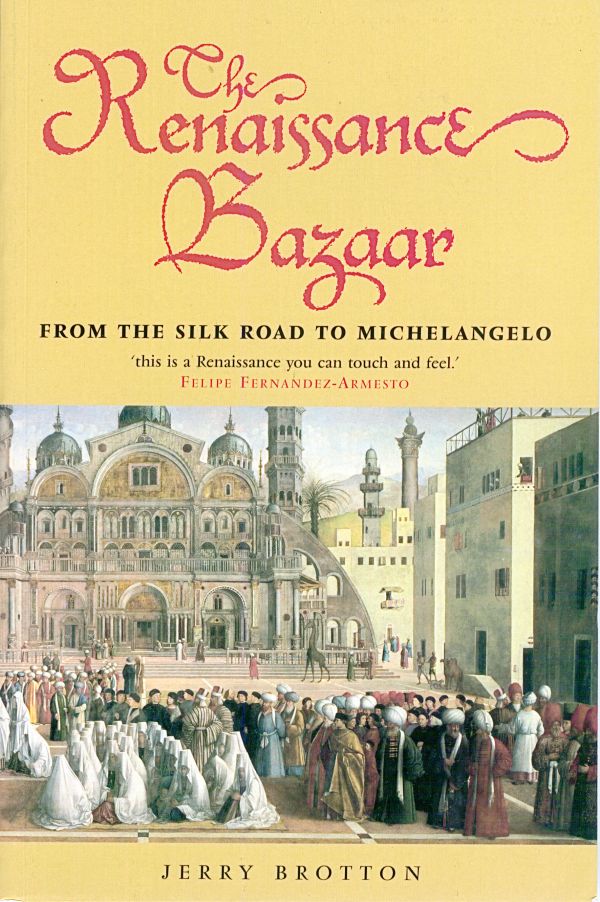Buy or gift a stand-alone digital subscription and get unlimited access to dozens of back issues for just £18.99 / $18.99 a year.
Please register at www.exacteditions.com/digital/cornucopia with your subscriber account number or contact subscriptions@cornucopia.net
Buy a digital subscription Go to the Digital Edition
From the Silk Road to Michelangelo
It is indeed bizarre that two books should almost simultaneously be published on the relationship between the Eastern market as represented by the bazaar and the evolution of the Italian Renaissance. Even more bizarre is that the two university publishers – Oxford and California – should have chosen not only the same painting (Gentile Bellini’s Saint Mark Preaching in Alexandria) but also the same details to embellish their covers.
This accidental parallelism apart, the two books are very different in their approach. Jerry Brotton inclines towards a series of imaginative essays, suggesting that there is still much work to be done investigating the formation of Renaissance thought, and that the answer lies in the east. Not only artifacts from the Eastern bazaars, but also the transmission of Islamic science and philosophy played a key role. He zooms in on Holbein’s The Ambassadors as a key item, and attaches iconic significance to many of the objects in the painting: “…one of the strings on the lute is broken, a deliberate symbol of discord” – and there is much in the same vein. More entertaining is his interpretation of Michelangelo’s David (“Rude when nude”), refuting its current status as a gay icon and instructing us to understand it as a straight political statement.
This is only the beginning: Brotton casts his net wide, covering the age of discovery, the invention of printing and, finally, literature and the world of the imagination. It all began in the East, he concludes, and for enlightenment we must go back to the bazaar.
In contrast to Brotton’s slightly flip approach in his book, Rosamond Mack attempts to be totally comprehensive. She has thoroughly documented the evidence for trade, for individual crafts such as silk and carpet-weaving, ceramics, glass, metalwork and bookbinding, as well as the visual arts. There seems to have been no stone unturned, nor any nook or cranny into which she has not peered between Italy and the mysterious East. Indeed, the book is a compendium of all you ever wanted to know on the subject, with excellent colour and monochrome illustrations, and eighty pages of notes, bibliography and index to boot.
Inevitably her text draws on numerous seminal articles by other scholars, and is none the worse for that, but it somewhat lacks the excitement of the chase. Judging from the cheerful photograph on the back flap, she is well pleased with her industry. In years to come, generations of students will be grateful for her diligence.
Which leads to a final question, posed by neither author. What exactly do we mean by “bazaar”? Both the Oxford English–Arabic Dictionary (1972) and Al-Mawrid (1999) define the term as “eastern market” and specifically use suq as a synonym. More informative is the inimitable Hobson-Jobson (1985 ed), which is worth quoting at length: “Hindu etc, from P. bazaar, a permanent market or street of shops. The word has spread westwards into Arabic, Turkish and, in special senses, into European languages, and eastward into India… it seems to have come to S. Europe very early… Pegolotti (Mercantile Handbook, c 1340) gives ‘bazarra’ as a Genoese word for ‘market place’.”
There seems no distinction between bazaar and suq, yet one belongs to the northern tier of Central Asian trade and the other to the heartlands of Islam. It would be interesting to see if there are structural, social and economic differences between the two, and whether this has any bearing on the authors’ thesis. After all, the greatest medieval market of all was the annual fair at Mecca, forbidden to the unbelievers.
1. STANDARD
Standard, untracked shipping is available worldwide. However, for high-value or heavy shipments outside the UK and Turkey, we strongly recommend option 2 or 3.
2. TRACKED SHIPPING
You can choose this option when ordering online.
3. EXPRESS SHIPPING
Contact subscriptions@cornucopia.net for a quote.
You can also order directly through subscriptions@cornucopia.net if you are worried about shipping times. We can issue a secure online invoice payable by debit or credit card for your order.

Cornucopia works in partnership with the digital publishing platform Exact Editions to offer individual and institutional subscribers unlimited access to a searchable archive of fascinating back issues and every newly published issue. The digital edition of Cornucopia is available cross-platform on web, iOS and Android and offers a comprehensive search function, allowing the title’s cultural content to be delved into at the touch of a button.
Digital Subscription: £18.99 / $18.99 (1 year)
Subscribe now